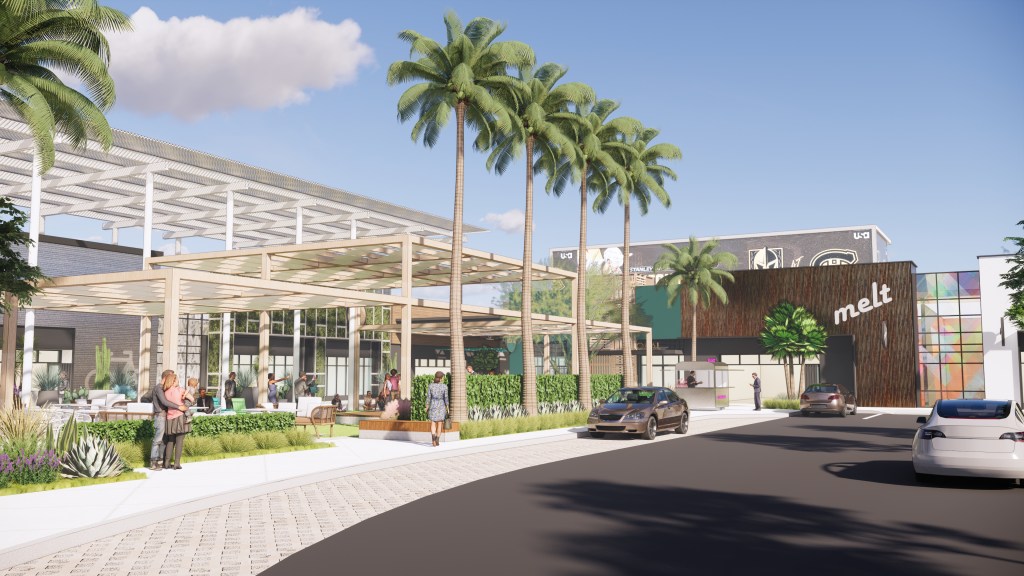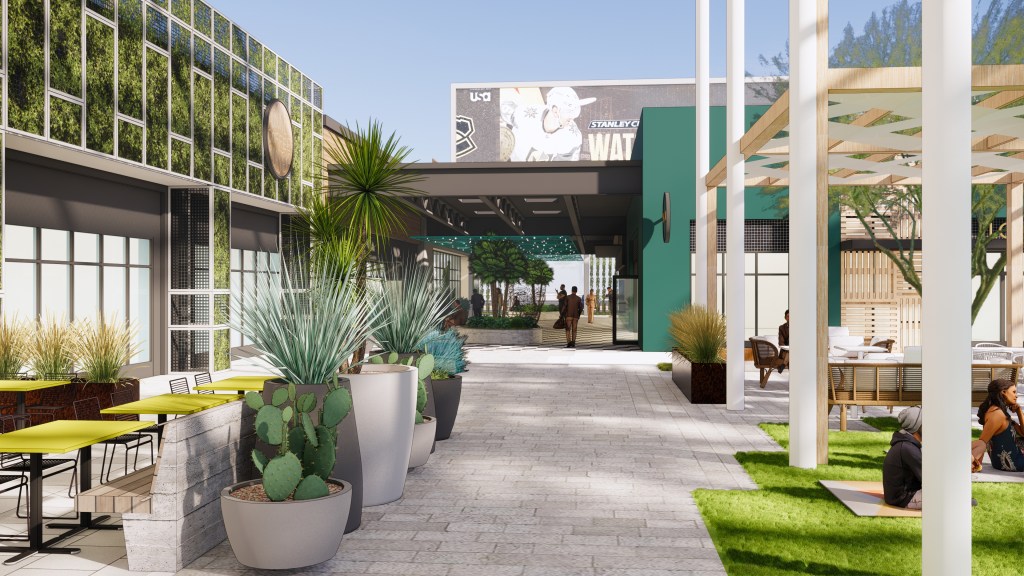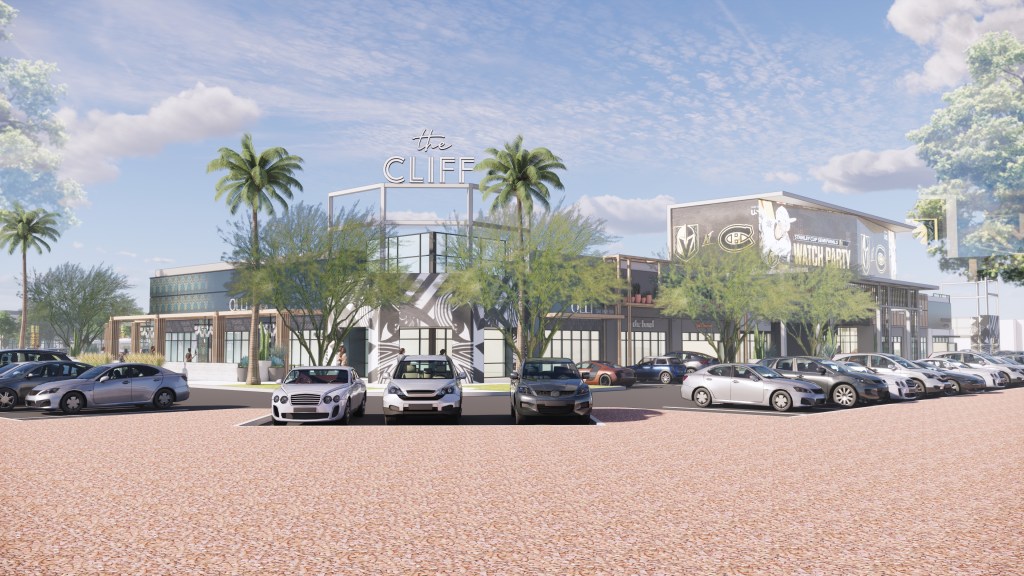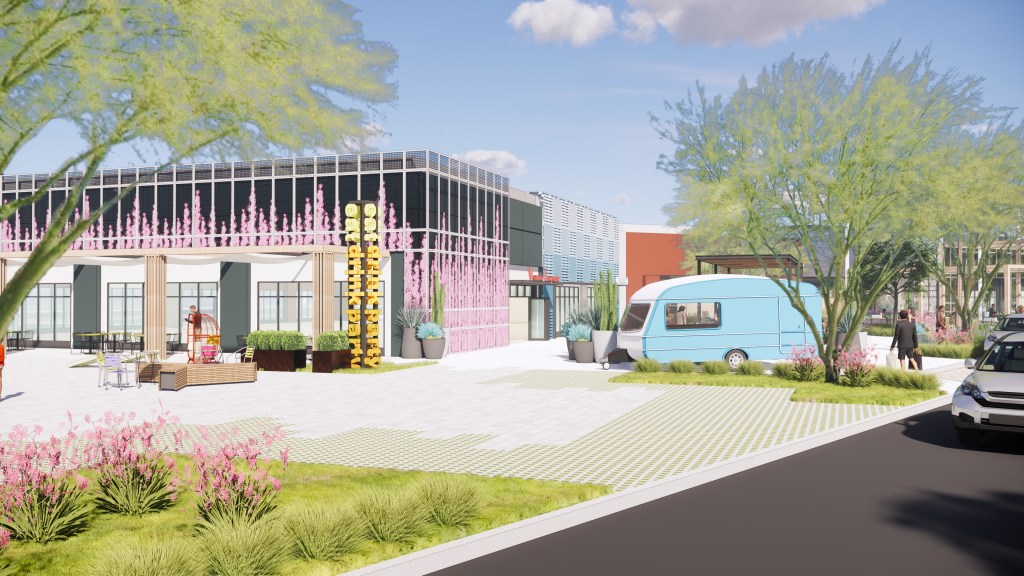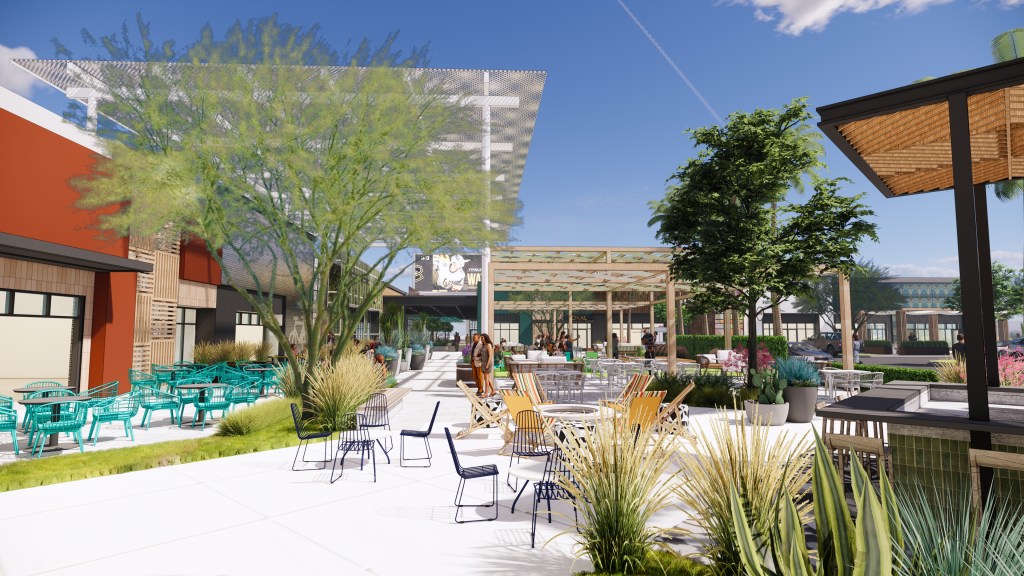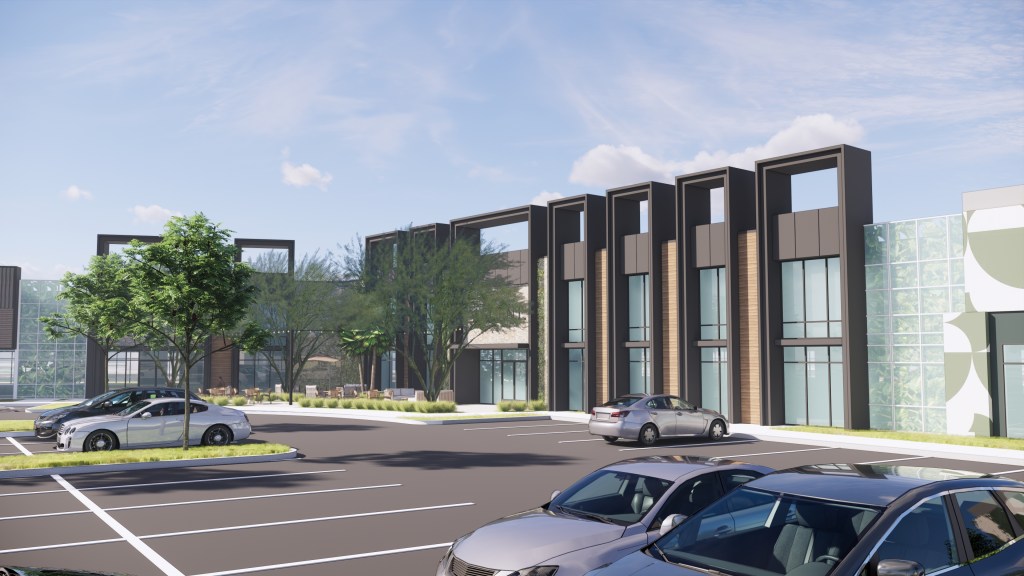Office-to-residential conversions have been one of the most popular choices for reviving outdated spaces across the country over the past few years. Through adaptive-reuse practices, many obsolete or vacated buildings have received a new life, but residential uses are not the best fit for all structures and across all markets.
In Henderson, Nev., some 16 miles southeast of Las Vegas, a joint venture is investing $30 million in redeveloping a former 100,000-square-foot, two-building office campus into an open-air retail center. And many could see this office-to-retail conversion as a bold move considering the retail industry has been facing its own set of challenges over the past decade. But the team behind the project is banking on local metrics and the fact that residents don’t have access to similar centers in the immediate area.
” data-medium-file=”https://www.commercialsearch.com/news/wp-content/uploads/sites/46/2024/06/Behind-the-project-V4.jpg?w=300″ data-large-file=”https://www.commercialsearch.com/news/wp-content/uploads/sites/46/2024/06/Behind-the-project-V4.jpg?w=827″ src=”https://www.commercialsearch.com/news/wp-content/uploads/sites/46/2024/06/Behind-the-project-V4.jpg?w=827″ alt=”Rendering of The Cliff” class=”wp-image-1004718963″ srcset=”https://www.commercialsearch.com/news/wp-content/uploads/sites/46/2024/06/Behind-the-project-V4.jpg 827w, https://www.commercialsearch.com/news/wp-content/uploads/sites/46/2024/06/Behind-the-project-V4.jpg?resize=300,145 300w, https://www.commercialsearch.com/news/wp-content/uploads/sites/46/2024/06/Behind-the-project-V4.jpg?resize=768,371 768w” sizes=”(max-width: 827px) 100vw, 827px”>
Together with Partners Capital and AO, CAST is working on The Cliff, an office-to-retail redevelopment project that will bring 25 new retail spaces to the market, ranging between 1,800 and 17,000 square feet, as well as a 26,000-square-foot covered outdoor dining lounge.
For specifics on The Cliff and the rise in adaptive reuse projects at large, Commercial Property Executive talked to Steve Neiger, managing broker at CAST. Along with its partners, the company acquired the two-building office property in 2023 for $17.2 million, aiming to completely remodel it and ultimately change the urban landscape in the city’s Green Valley neighborhood.
READ ALSO: Charting Luxury Retail’s Course in the New Economy
” data-medium-file=”https://www.commercialsearch.com/news/wp-content/uploads/sites/46/2024/06/SteveNeiger-edited.jpg?w=300″ data-large-file=”https://www.commercialsearch.com/news/wp-content/uploads/sites/46/2024/06/SteveNeiger-edited.jpg?w=1024″ src=”https://www.commercialsearch.com/news/wp-content/uploads/sites/46/2024/06/SteveNeiger-edited.jpg” alt=”Steve Neiger, Managing Principal at CAST, on the office to retail conversion trend” class=”wp-image-1004718953″ srcset=”https://www.commercialsearch.com/news/wp-content/uploads/sites/46/2024/06/SteveNeiger-edited.jpg 1500w, https://www.commercialsearch.com/news/wp-content/uploads/sites/46/2024/06/SteveNeiger-edited.jpg?resize=150,150 150w, https://www.commercialsearch.com/news/wp-content/uploads/sites/46/2024/06/SteveNeiger-edited.jpg?resize=300,300 300w, https://www.commercialsearch.com/news/wp-content/uploads/sites/46/2024/06/SteveNeiger-edited.jpg?resize=768,768 768w, https://www.commercialsearch.com/news/wp-content/uploads/sites/46/2024/06/SteveNeiger-edited.jpg?resize=1024,1024 1024w” sizes=”(max-width: 1500px) 100vw, 1500px”>
Tell us more about the feasibility of this office-to-retail conversion and how you came up with the idea.
Neiger: It started when we were touring the suburbs with a celebrity chef from the Strip, and there were very few good options in Henderson for a brand of his caliber. Green Valley Ranch is the most desirable commercial area in all of Henderson and was in desperate need of better retail. We saw these office buildings and said: What if?
We did some research on the property, assessed the viability of the game plan, current zoning of the property, and rules at the City of Henderson and realized we could make this happen.
Why will this new retail destination be known as The Cliff? What’s behind the name choice?
Neiger: The naming of The Cliff started as an inside joke. The CAST Nevada team was on the corner of the property, standing on top land elevated about 10 feet above St. Rose Parkway, admiring the view of the Strip and the great traffic counts. It felt like we were standing on a cliff, so one of us looked at Chris Clifford, one of the CAST partners, who we sometimes call ‘Clifford’ or ‘Cliffy,’ and said, ‘We should call it The Cliff.’ It was a joke at the time…but it stuck. After a few weeks of referring to the project as ‘The Cliff,’ we knew there was no going back.
What are some of the major changes that you need to make to the former office space to turn it into The Cliff?
Neiger: Utilities are one of the biggest changes to the property as we prepare for the arrival of numerous new restaurants. Conversion requires bringing gas to the property along with huge, incredibly expensive electricity upgrades. Not to mention we’re also changing every square inch of the exterior surface with far more exciting finishes. We have also been working closely with the municipality to create an Entertainment District overlay to ensure we can deliver the kind of product we want.
Considering all you know today about this building, what other parts of the office-to-retail conversion process do you expect to be difficult?
Neiger: We got relatively lucky with the municipality, zoning and the change of use of the property in this particular case. However, the utility situation is incredibly challenging because the landscape is constantly changing in terms of what’s available, where, and for how much, especially for electricity.
Additionally, business licensing in most municipalities is far behind the retail and food & beverage industry, and that has been no exception in Southern Nevada. We have several prospective tenants, and we’re working hard with the municipality to figure out how we can get them into our property because there’s just not a relevant license for their business type.
What will be the distinctive elements of The Cliff that will make this lifestyle retail center stand out?
Neiger: We’re incorporating several design aspects that haven’t been seen in suburban Southern Nevada. We’re installing an OLED reader board sign that is over 2,100 square feet in surface area. We’re doing a large shaded outdoor gathering space complete with a full outdoor bar and a stage. We’re also incorporating smaller format food and retail kiosks into the courtyard. All of these different elements allow us to bring an unprecedented level of common-area programming to our center, which is something the community hasn’t experienced before.
READ ALSO: NAREE Special Report—Why Conversion Isn’t CRE’s Magic Bullet
What are your thoughts on adaptive reuse becoming increasingly popular among developers?
Neiger: We encourage others to exercise caution when assuming that adaptive reuse presents a significantly lower cost compared to new construction. In reality, this is often not the case, particularly when extensive repurposing is involved. It’s also worth mentioning that there are environmental requirements with adaptive reuse and other similar conversion projects. For example, most municipalities are understandably quite strict about lead and asbestos testing and subsequent abatement when doing adaptive reuse. Structural issues can also be a considerable and often costly consideration when dealing with older buildings, even with simpler updates such as adding windows and doorways.
Finally, just because an adaptive-reuse idea makes sense in terms of market dynamics and economic viability doesn’t mean the community will get behind it. Changing the use of a property often opens up the project to more scrutiny from the general public. We’re seeing the rise of “NIMYBism”, which underscores the importance of carefully navigating stakeholder perspectives and considerations when undertaking property use transformations.
What are some of the key factors to consider in adaptive reuse for retail properties?
Neiger: Retail is a special animal. In our world, the key metrics are demographics, traffic counts, visibility of the property, and municipal considerations such as zoning. If all these factors come back with great numbers and green lights, then you’ve got a chance to do something great.
But you can’t forget about the property itself. It must be the right building with the right bones. Our buildings here in Southern Nevada could have been the same 100,000 square feet of office but stacked into four stories, and this project would have never worked. We find that retail above the ground floor is not as successful in most cases. With retail, we also need to consider building depth and ceiling clearance.
Finally, parking is a big one, and it is probably the reason you may never see an industrial park turned into a retail/restaurant adaptive-reuse project. We had another exciting prospect in California recently, but we couldn’t make it work because it was severely underparked, and parking garages just weren’t a viable option.
How do you expect the adaptive-reuse trend to evolve? Will we see more of these projects going forward?
Neiger: We anticipate seeing more of these projects moving forward, provided the local municipalities can keep up with the private sector and the way things are going. In the coming years, we expect to see more density in existing mature trade areas of U.S. cities, which means more opportunities for adaptive-reuse projects, especially with mixed-uses.
One conversion that has been discussed frequently since COVID-19 is turning office buildings into residential units. Developers all over the country have been trying to figure this out in their markets, but it’s a lot more expensive and a lot more difficult than folks give developers credit for. If you have an empty high-rise office building in your city and you keep wondering why they don’t just turn it into residential condos or apartments since we have somewhat of a housing supply issue right now…well, chances are somebody already thought of it, and tried, or is currently trying to make that work.
This post was originally published on 3rd party website mentioned in the title of this site


